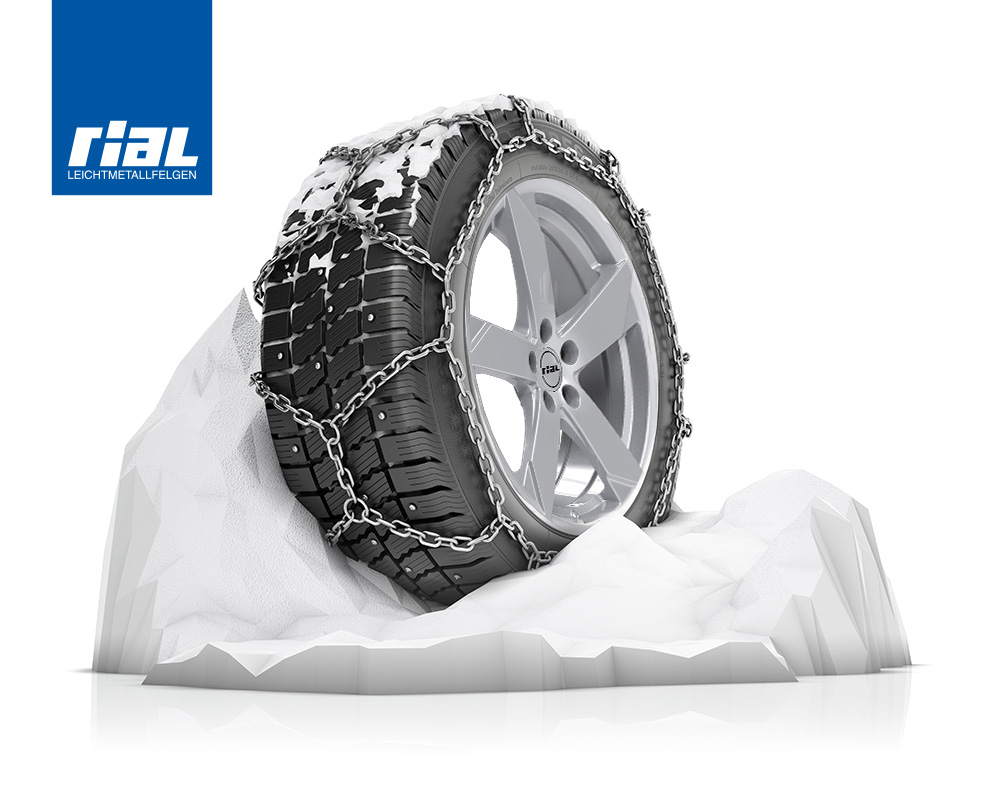
How do you find the right snow chain for your car? Are snow chains suitable for alloy wheels? Does every wheel need a snow chain? What is important to note when putting them on? We’ll show you what to keep in mind.
Snow chains and alloy wheels – a dream team?
Many drivers, especially those with aluminum wheel rims, still prefer not to put on snow chains in the winter months, often due to the fear of scratching their beloved alloys. This fear is usually unfounded, though.
Generally speaking, most snow chains can be used on alloy wheels. Many manufacturers offer snow chains that are specially designed to protect the wheels from damage. Find out whether your alloy wheels are suitable for use with snow chains by reading the type approval certificate. Alternatively, you can use our wheel configurator.
Which wheels should I put snow chains on?
The rule here is that the snow chains should be mounted on the wheels of the drive axle. This means that they are mounted on the front wheels for front-wheel drive, on the rear wheels for rear-wheel drive, and on the wheels of both axles for four-wheel drive. In the latter case, you also have the option of only using chains on the permanently driven axle. The owner’s manual will tell you which of your car’s axles is permanently driven.
Manufacturers typically deliver snow chains with installation instructions to heed when putting them on. Regardless of the brand, it is important to make sure the snow chains sit firmly on the tire and do not move around.
Alloy wheels that extend too far beyond the tire flank are susceptible to scratches. There is a risk that the chain and wheel rim may rub against each other. The chain lock can also damage the wheel, so make sure that the lock and chain links do not rest directly on the wheel rim. It is important to avoid friction, but there should still be a small amount of space. To achieve this, the wheel cannot be too high, and the chain must be taut.
Take your time for this process. Practice makes perfect, and attaching the chains will eventually become routine. If you want to be on the safe side, some manufacturers also offer wheel protection systems.
Our tip: snow chains that don’t use any chain parts to stretch over the alloy wheel will be particularly gentle on your wheels.
Chained up and ready to go
Once the chain is in place, you should drive the car a short distance. After about 100 meters, you should check whether the snow chain is still firmly in place or has shifted and needs adjusting. This is to protect the alloy wheels and car body. The magic word for snow chains is “retightening”. This is the only way to be sure that the chain always fits perfectly.
And don’t forget: the maximum speed allowed when driving with snow chains is 50 kilometers per hour, and in some areas just 30 kilometers per hour.
Are chains mandatory?
Especially in alpine regions, there is often a snow chain requirement. Even if parts of your driving route are snow-free, failure to comply with this rule will result in fines.
Please note: In Austria, snow chains must comply with the national standard ÖNORM V 5117. If the snow chain has this certification, this is usually noted directly on the chain itself. The specifications vary depending on the country, so be sure to look up the country-specific requirements if you intend to use snow chains abroad.
More things to keep in mind
For installation when out and about, it makes sense to keep a pair of gloves in your trunk along with the snow chains. You will also need to put on a safety vest when you start the installation process on the roadside.
Here’s one more important tip: each time you use them, you should check your snow chains for damaged parts before putting them on your wheels. If a chain link is damaged, we recommend replacing it immediately. Otherwise there is a risk that the chain will break while you’re driving.


